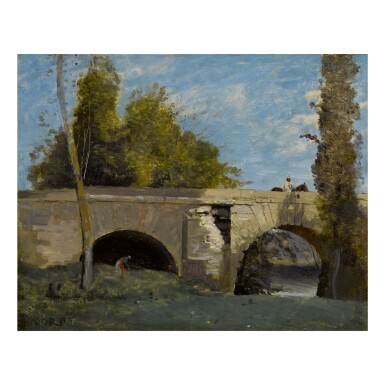19th Century European Art
19th Century European Art

Property of a Lady
JEAN-BAPTISTE-CAMILLE COROT | MANTES- DEUX ARCHES DU PONT AVEC UN CAVALIER
Auction Closed
May 22, 03:43 PM GMT
Estimate
100,000 - 150,000 USD
Lot Details
Description
JEAN-BAPTISTE-CAMILLE COROT
French
1796 - 1875
MANTES- DEUX ARCHES DU PONT AVEC UN CAVALIER
signed COROT (lower left)
oil on panel
12⅝ by 16 in.
32 by 40.5 cm
We would like to thank Martin Dieterle and Claire Lebeau for kindly confirming the authenticity of this lot.
Louis Onésime Hermeline, Limay, France (gifted directly from the artist and sold, his posthumous sale, July 27, 1896)
M. Chamouillet (acquired at the above sale)
Arnold & Tripp, Paris (acquired in August 1896)
James Staats Forbes, London (by 1904)
Mary Frances Allen, Connecticut (and sold, her estate, Sotheby's, New York, May 26, 1994, lot 14, illustrated)
W.M. Brady & Co., New York
Alfred Robaut, L'oeuvre de Corot, catalogue raisonné et illustré, Paris, 1965, vol. III, p. 102, no. 1531, illustrated p. 103
Rodolphe Walter, Corot à Mantes, Paris, 1997, p. 160-1, illustrated p. 160 and pl. XI
Painted circa 1868-70, when Jean-Baptiste-Camille Corot was at the height of his prolific career, Mantes-deux arches du pont avec un cavalier conjures the crisp air of Mantes, a medieval town on the Seine thirty miles north of Paris. The idyllic hamlet attracted artists before Corot, such as J.M.W. Turner, and proved popular with Charles-François Daubigny, Alfred Sisley and Paul Signac, whose composition The Seine at Mantes (1899-1900, Kröller Müller Museum, Otterlo, The Netherlands) is anchored by the twelfth century Gothic cathedral of Notre-Dame which dominates the townscape. Corot also painted the cathedral throughout his career (see Mantes (Morning), 1865, Musée des Beaux-Arts, Reims) as he visited his close friend François-Parfait Robert, the local magistrate who hosted the artist from the 1840s until the final decade of his career.
Corot revisited this bridge often, and it appears either in the background or as the main subject of at least ten compositions. Dated to the same period, Le pont de Mantes (environs de Paris), in the collection of the Louvre (fig. 1) shows a great depth of field with a defined foreground, while the present work focuses on a flattened middle ground. The bold arrangement of shapes are defined by planes of brilliant color, a showcase for Corot’s painterly experimentation which inspired generations of artists who followed him.
